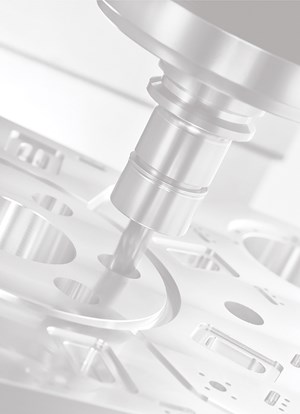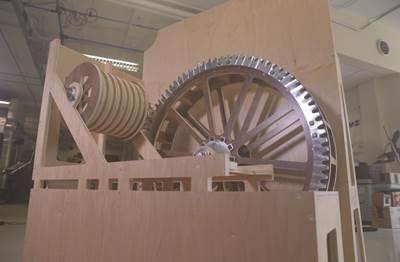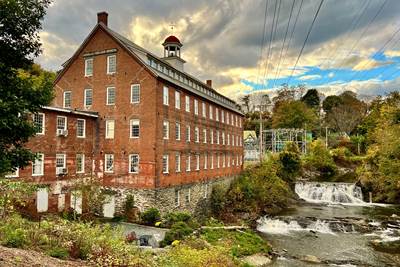Tracing Domestic Manufacturing’s History at the American Precision Museum
The American Precision Museum connects new generations to the story of domestic precision manufacturing. Find out how it’s bringing new chapters of that story to life.
Share


The story of the American Precision Museum, like the history of precision manufacturing it portrays, is a history of refinement. Current museum director Steve Dalessio is spearheading changes to make the museum a destination for veteran machinists and new generations of potential machinists alike. At the same time, he hopes to never lose sight of the importance of the museum’s location: the Robbins and Lawrence Armory, constructed by the fathers of precision machining in the United States.

The Robbins and Lawrence Armory’s water wheel powered belts that, while noisy, were effective in consistently driving machine tools.
Robbins and Lawrence (and Kendall)
The history of the Robbins and Lawrence Armory begins in the 1840s, which is also when the museum pinpoints the birth of American precision manufacturing.
Prior to this time, manufacturing tasks were performed by hand or heavily manual processes. This created particular challenges in rifle manufacturing. Round stock was not yet available, so gunsmiths had to forge round barrels by using a half-round mold and pounding flat stock into it to make a full circle. For other parts, they would cast near-net shapes and file away material for the final fit. These sorts of operations made each rifle a unique product, and replacing only one part of the complicated whole was often unfeasible.
Interchangeable precision parts were the white whale of the era. Dalessio says that Eli Whitney and Simeon North came close — but neither were able to reach the level of precision required for widescale commercial production or the burgeoning defense industry. When the U.S. government sent out a contract for 10,000 rifles with interchangeable parts, multiple companies vied for it. This is when Samuel Robbins approached gunsmithing duo Richard Lawrence and Nicanor Kendall, offering funding if they thought they could succeed.
The three set to work building a facility for the task, complete with workmen’s quarters, foundries and an assembly building. But what tied it together was the armory where the American Precision Museum is located. This building is directly adjacent to the river, and the basement sported a water wheel 18 feet in diameter to provide power to the machines above. This wheel was smaller in diameter than something that could be found in traditional grist mills, but the team made it very wide, Dalessio says. This made it effective as a breast wheel, where the water would come in just above center, then flow down and push the wheel along with it. Dalessio says this made a large impact on the horsepower necessary to generate power for the machines in the building.

In addition to precision machine tools, the museum hosts an exhibit of precision measurement tools. Some are the early forms of micrometers and optical comparators that can still be seen today in job shops, while others are specialized equipment for measuring heat and velocity.
It's important to note that Robbins and Lawrence (the pair of whom bought out Kendall shortly into their partnership) did not invent most of their machines. Rather, they traveled up and down the Connecticut River to search for machine tools they could leverage for their burgeoning production line and staff members who had the ingenuity and adaptability necessary for the task. The museum now displays several examples of these kinds of tools, including mills from Thomas Blanchard and Frederick Howe, the latter of whom invented several machines within the museum building.
When working in combination, these machines improved part accuracy, repeatability and cycle times. Assembly of a rifle stock went from a 24-hour task to a two-hour task, with the whole enterprise of making each rifle shortened from 115 hours to 31 hours. What’s more, the process became repeatable enough that parts could be exchanged between rifles (or damaged parts replaced). The cost per part also decreased sharply with these efficiency increases.
Robbins and Lawrence were able to fulfill their initial contract, and soon after they represented the United States across the Atlantic at the 1851 Great Exhibition of Industrial Works at the Crystal Palace in London. A display at the museum discusses this event, where the interchangeable parts for the rifles intrigued the British so much that several parties tried to order not just the rifles, but the machines tools behind what they quickly dubbed the “American System of Manufacturing.” Dalessio adds that this is when Robbins and Lawrence started producing machine tools.
The pair soon followed this expansion by attempting to enter the railroad market. Dalessio says this spread the company too thin, however, and it went out of business by 1856. Robbins and Lawrence’s employees spread out across the Connecticut River Valley, founding shops that adopted the American System of Manufacturing and earning the area the nickname “Precision Valley.” As for the Armory, it became a cotton mill in 1866 and was the home of a wide variety of businesses for the next century.

Dalessio says a big draw for the museum is Bridgeport serial number 1. The museum’s collection also includes a Bridgeport machine with no serial number — the personal machine made for its inventor, Rudolph Bannow.
From History, Innovation
In the mid-1960s, the Robbins and Lawrence Armory was nearly slated for demolition. Windsor, Vermont-native Ed Battison, a one-time collector and curator for the Smithsonian Museum, bought the building instead. Battison had collected historical machine tools for years and wanted to know the purpose, history and context behind them, Dalessio says. Buying the Robbins and Lawrence Armory, pushing for it to be added to the list of historic places and opening the American Precision Museum inside helped Battison achieve this goal.
Battison built a board for the museum and remained its executive director until 1991. Since then, the museum has undergone several leadership changes, most recently appointing Steve Dalessio as executive director in 2019.
Steve Dalessio joined the museum’s board in 2014, and saw the executive director at the time try to keep the machines and exhibits behind glass, much like a traditional museum. But after that director departed (and a yearlong search for a new executive director), Dalessio took the position himself. The board advised him that the museum needed to become more relevant to its audience or risk fading out of existence. His response was to remodel the museum and specifically target an audience of manufacturing professionals, with an equal emphasis on making the manufacturing industry more appealing to younger attendees.

Not every machine in the museum came into its possession well-documented. The APM displays some machines meant for purposes unknown to the staff. It invites visitors to guess the purposes of these “mystery machines” to help identify them.
Much of the remodel took place during the COVID-19 pandemic. Dalessio and another board member realized the museum’s timeline of events started too late and introduced a section about handcrafting parts. Historical machines that were previously behind glass are now out in the open so guests can better see how they operate. One of the museum’s big attractions, Bridgeport serial number 1, stands in the middle of the floor.
But still, Dalessio believes new generations would be bored with only old technology — and that it would not be very effective for getting them interested in the industry. As such, the American Precision Museum has put together an “Innovation Station” in partnership with technology OEMs that features more modern equipment. Okuma five-axis mills and Desktop Metal 3D printers appear in videos at this station alongside working equipment. This in-museum equipment includes FANUC robots supplied by Gosiger and Universal Robots, an UltiMaker polymer 3D printer, a CNC mill and lathe from Haas Automation, Kennametal tools and more. Dalessio positions the Innovation Station as part of a clear evolutionary line visitors can trace through the museum: Hand-made parts moved onto machines, then subsequent machine generations removing more and more of the human hand from individual runs to decrease variability.

While much of the museum focuses on traditional, subtractive manufacturing, Dalessio wants to show off the full spectrum of modern manufacturing techniques to new visitors. As such, the museum has polymer 3D printing equipment, as well as an interactive station showing how the process works.
The Future of Manufacturing and the Museum
The educational aspect of the museum is at the forefront of Dalessio’s mind, especially as he considers the technological and demographic changes actively taking place across the industry. Demonstrations at the Innovation Station (both interactive and expert-led) play one part in how he hopes the museum addresses technological change, while placards around the museum tell the stories of people from all walks of life taking part in the early decades of American precision manufacturing.
In the future, Dalessio and the American Precision Museum team hope to renovate the back half of the museum’s second floor as an educational area and conference center. This will mean parting with some of the museum’s collection in storage, which makes this a slow-going effort. There are records attached to many items in the collection, and the team aims to understand why something was kept before parting with it. In addition to records and papers — several of which relate to companies that no longer exist — stored items include what is potentially the final extant Gilman machine used on battleships. This machine combines a drill press, lathe and mill into one machine, all before the invention of CNC.

The American Precision Museum is not able to display all the machines in its collection. This Gilman machine is one of the machines in its storage area, and possibly the last of its kind. These machines were used on battleships to perform a variety of manufacturing tasks in a compact space — the pictured machine can serve as a drill press, lathe and mill.
Ultimately, Dalessio and the museum’s director of development and communications, Dave Eastman, see this sort of a machine as more of the trend going forward than just a race for shorter cycle times (after all, as Dalessio says, any future optimizations will be smaller and smaller — not every optimization can have the magnitude of shortening 115 hours to 31). While he has no doubt iteration and improvement on cycle times will continue through new machine features and better optimized tooling, when stepping back and looking at the full picture of manufacturing, Dalessio says done-in-one machining is the most likely source of future innovation. Eastman also expands this to automation, as manufacturers try to perform more work with staff sizes that are shrinking with demographic shifts faster than they grow.
Eastman says introducing new generations to manufacturing is the last piece of the puzzle for preserving the field’s history, and the museum’s staff is actively working to change the perception of manufacturing as a “dark, dirty, dull and dangerous” field. Dalessio follows up that they would also like to foster an understanding that there is no one path into manufacturing. Rather, shopfloor work can begin directly through an apprenticeship, through a technical school degree or through a four-year degree. He says the possibilities grow even wider when considering the overall range of careers necessary for manufacturing work to take place. It’s not just machine operators that manufacturers need: purchasing, engineering and machine maintenance roles are also important. After all, it took both investor Robbins and shopfloor expert Lawrence to jumpstart American precision machining.
Related Content
Navigating Large-Scale CNC Machining: Suburban Tool’s Niche Strategy to Stay Competitive
Facing increasing competition from lower-cost imports, Suburban Tool made a move toward large-scale, in-house machining. By identifying a niche in large, precision angle plates and tombstones, the company has strengthened its ability to control quality and protect its reputation.
Read MoreDN Solutions America Unveils Impressive Chicago Technical Center at IMTS 2024
New tech center is serving as a cutting-edge showroom and a technological hub for advanced machining applications.
Read MoreMaking the Case for Table Changers
Table changers are an often-overlooked automation solution. In the right scenario, they can offer significant productivity gains while keeping your workflow familiar and manageable.
Read MoreHurco Machine-Tending Solutions Support Range of Machining Centers
IMTS 2024: Hurco is demonstrating the capabilities of machine-tending automation through ProCobots-Hurco integration. The company is also showcasing a range of CNC machines.
Read MoreRead Next
Mastercam, Haas Partner with American Precision Museum
Mastercam applications engineers designed and machined a scaled-down version of the waterwheel originally used to power the factory that now houses the American Precision Museum.
Read MoreKennametal Partners With American Precision Museum
The American Precision Museum will showcase Kennametal tools in its makerspace, where visitors can explore and learn about different machining solutions.
Read MoreVideo Tour: Inside the American Precision Museum
Where did precision manufacturing begin in the U.S.? What led to it, and how has it changed? Join us on this tour of the American Precision Museum, where Executive Director Steve Dalessio tells us the story of precision manufacturing’s birth — right from the place where it happened.
Read More





























